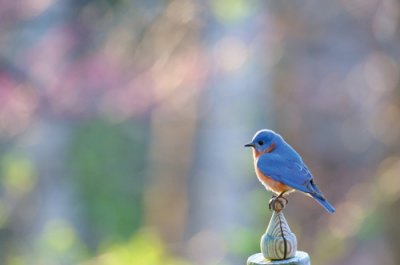
As spring finally emerges after a long, punishing winter, the Eastern bluebird appears, awaking all living creatures with his melodious songs. Bluebirds are not the only ones singing. This docile bit of fluff has an uncanny ability to make people happy. “The bluebird is like a speck of clear blue sky seen near the end of a storm, reminding us of an ethereal region and a heaven which we had forgotten,” wrote Henry David Thoreau.
Dana Bucci has three bluebird houses on her Nod Road property. On warm summer nights, Bucci and her husband Paul sit outside and watch the bluebirds. “They are brilliant in color and bounce around our yard. It truly makes me happy,” says Bucci.
A radiant blue with a warm reddish breast, the male bluebird is beautiful as he is charming. According to Tom Meyer—a trained bluebird rehabilitator, referred to as “Mr. Bluebird” in Bedford, where he’s lived for 42 years—the male bluebird arrives in the Northeast in late February, ahead of his mate, and searches for a home worthy to present to her. Once he finds it, he beckons her with joyful chirps, as if to say, “Come! See for yourself the nest box I’ve selected in which to raise our family!”
“He will sit on top of the house, fluttering, and may show her three or four spots, just like a real-estate agent,” says Meyer, chuckling. The female—with her lighter-blue wings and tail, brownish throat and breast, and gray crown—gets busy creating a nest and promptly lays four to five eggs. She diligently incubates them for two weeks, and once they are hatched, she and her mate share feeding their brood insects. “They kind of alternate. You’ll see the female go in and then the male; and as the babies grow, the insects get bigger and bigger,” says Meyer.
It’s nature at work—a beautiful story of cohabitation, parenting, and shared responsibility. But nature sometimes needs a hand. For the decades of suburban growth, spanning 1900 to 1970, it was not easy for the kindly bluebird to find a natural nesting cavity. If not for the effort and intervention of bluebird-loving humans, spring would arrive somewhat cheerless in these parts.
Melodee Benoit, bluebird monitor at the GlenArbor Golf Club in Bedford Hills, is dedicated to the preservation of the Eastern bluebird. When urbanization caused the species to compete with other cavity-nesters for a place to raise their young, the submissive bluebird lost out to more aggressive birds such as the house sparrow and European starling. “Back in the 1970s, a huge part of increasing the bluebird population was making people aware of the bluebird’s plight and how they weren’t thriving. Backyard bluebirders started putting up bluebird boxes,” explains Benoit.
While having a backyard nest box is one way to ensure the population of bluebirds continues to increase, Benoit says, “It’s a commitment. If someone wants to have a bluebird box, they’ve got to monitor it. That’s part of the success. You need to know what’s going on inside the box. You need to check on the babies.” Eastern bluebirds nest up to three times a season. “When they’re done nesting, you need to clean it out right away because they need to get back in there and do their thing again.”
The preservation and recovery of the Eastern bluebird continues throughout the Northeast. “It’s hard not to love this little bird,” says Benoit. “If I could use one word to describe the bluebird, I’d say magical,” adds Meyer.
The birds nest in the Bucci family bluebirds boxes, which are spread about 40 yards apart in the yard. “It is amazing. I have about 15 birdhouses around my yard, but they always go to the bluebird house,” says Bucci. “How do they know?”
*This article appeared in Ridgefield Magazine.